英语作文 城市化的利弊(Advantages and Disadvantages of Unbanization)-精品
城市化的利与弊英语作文

城市化的利与弊英语作文High rise buildings bring benefits as well as problems in the process of modernization and urbanization of large cities. In order to solve the housing problem, high-rise buildings have appeared in more and more big cities. High rise buildings have their own advantages and disadvantages.Of course, in urban areas where land is expensive, they take up less space. Some people say that high-rise buildings can bring amazing beauty to the city. Some buildings are apartments, which can accommodate hundreds of families under a roof.On the other hand, high-rise buildings can be very dangerous. What if there is a fire or an earthquake? In short, high-rise buildings are necessary We must take effective measures to solve the problems of water supply and power supply.中文翻译:在大城市的现代化和城市化进程中,高层建筑既带来了好处,也带来了问题。
城镇化的缺点和优点的英语作文
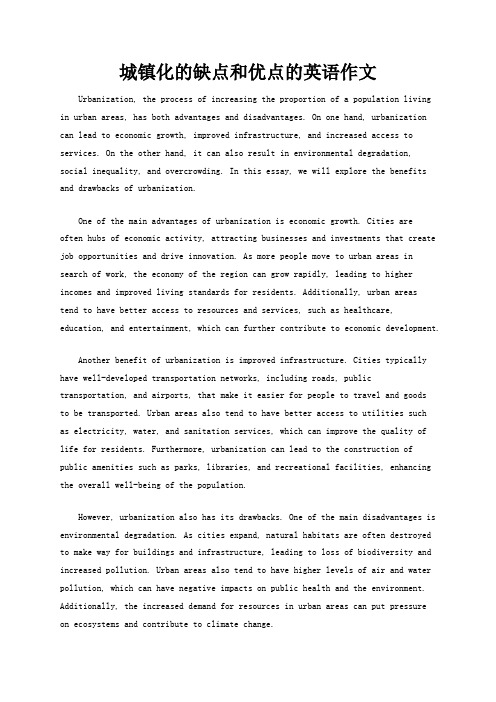
城镇化的缺点和优点的英语作文Urbanization, the process of increasing the proportion of a population living in urban areas, has both advantages and disadvantages. On one hand, urbanization can lead to economic growth, improved infrastructure, and increased access to services. On the other hand, it can also result in environmental degradation, social inequality, and overcrowding. In this essay, we will explore the benefits and drawbacks of urbanization.One of the main advantages of urbanization is economic growth. Cities are often hubs of economic activity, attracting businesses and investments that create job opportunities and drive innovation. As more people move to urban areas in search of work, the economy of the region can grow rapidly, leading to higher incomes and improved living standards for residents. Additionally, urban areas tend to have better access to resources and services, such as healthcare, education, and entertainment, which can further contribute to economic development.Another benefit of urbanization is improved infrastructure. Cities typically have well-developed transportation networks, including roads, public transportation, and airports, that make it easier for people to travel and goods to be transported. Urban areas also tend to have better access to utilities such as electricity, water, and sanitation services, which can improve the quality of life for residents. Furthermore, urbanization can lead to the construction of public amenities such as parks, libraries, and recreational facilities, enhancing the overall well-being of the population.However, urbanization also has its drawbacks. One of the main disadvantages is environmental degradation. As cities expand, natural habitats are often destroyed to make way for buildings and infrastructure, leading to loss of biodiversity and increased pollution. Urban areas also tend to have higher levels of air and water pollution, which can have negative impacts on public health and the environment. Additionally, the increased demand for resources in urban areas can put pressure on ecosystems and contribute to climate change.Social inequality is another downside of urbanization. While cities offer opportunities for economic advancement, they can also exacerbate existing inequalities. In many urban areas, there is a stark divide between the wealthy and the poor, with marginalized communities often living in overcrowded and underserved neighborhoods. This can lead to social unrest, crime, and other social problems that can undermine the overall well-being of the population. Furthermore, rapid urbanization can strain social services and infrastructure, leading to issues such as homelessness, inadequate housing, and lack of access to basic amenities.In conclusion, urbanization has both advantages and disadvantages. While it can contribute to economic growth, improved infrastructure, and better access to services, it can also result in environmental degradation, social inequality, and overcrowding. As cities continue to grow and evolve, it is important for policymakers to address these challenges and work towards creating sustainable, inclusive urban environments that benefit all residents.。
120词城市化的优势和劣势英语作文
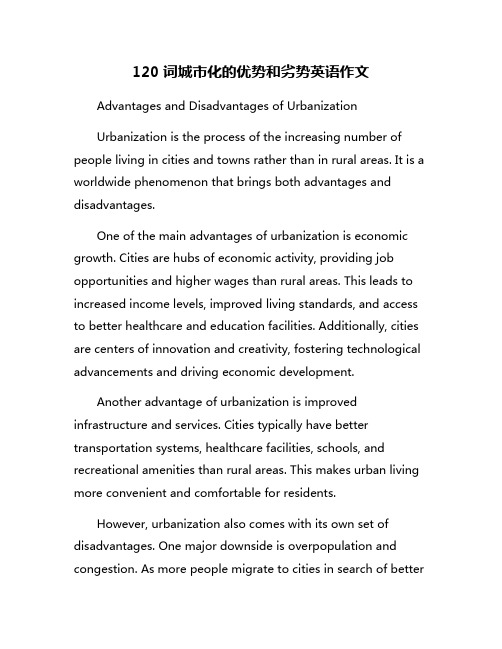
120词城市化的优势和劣势英语作文Advantages and Disadvantages of UrbanizationUrbanization is the process of the increasing number of people living in cities and towns rather than in rural areas. It is a worldwide phenomenon that brings both advantages and disadvantages.One of the main advantages of urbanization is economic growth. Cities are hubs of economic activity, providing job opportunities and higher wages than rural areas. This leads to increased income levels, improved living standards, and access to better healthcare and education facilities. Additionally, cities are centers of innovation and creativity, fostering technological advancements and driving economic development.Another advantage of urbanization is improved infrastructure and services. Cities typically have better transportation systems, healthcare facilities, schools, and recreational amenities than rural areas. This makes urban living more convenient and comfortable for residents.However, urbanization also comes with its own set of disadvantages. One major downside is overpopulation and congestion. As more people migrate to cities in search of betteropportunities, cities become overcrowded, leading to traffic jams, pollution, and strain on infrastructure.Another disadvantage of urbanization is the growing wealth gap. While cities offer better job opportunities and higher incomes, not everyone benefits equally from urbanization. The wealth gap between the rich and the poor widens, leading to social inequality and poverty in urban areas.Additionally, urbanization can lead to environmental degradation. The rapid expansion of cities results in deforestation, air and water pollution, and loss of biodiversity. This poses a threat to the environment and ecosystem, affecting both urban and rural areas.In conclusion, urbanization brings both advantages and disadvantages. While it can drive economic growth, improve infrastructure, and enhance living standards, it also leads to overpopulation, social inequality, and environmental degradation. To mitigate the negative impacts of urbanization, sustainable planning and development strategies are essential to create livable, inclusive, and environmentally-friendly cities.。
城市化利弊英语作文
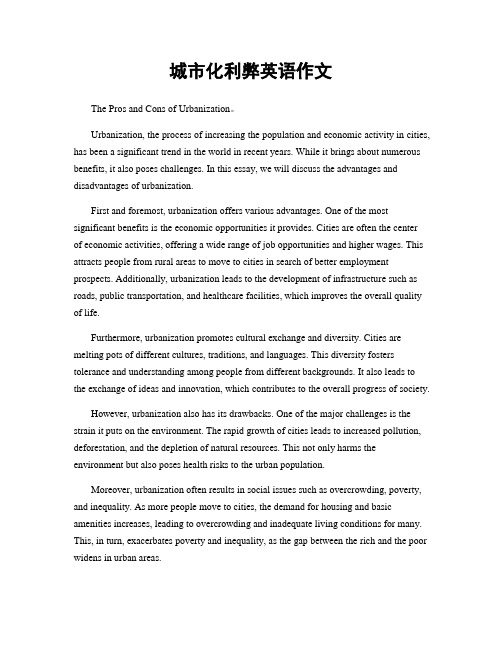
城市化利弊英语作文The Pros and Cons of Urbanization。
Urbanization, the process of increasing the population and economic activity in cities, has been a significant trend in the world in recent years. While it brings about numerous benefits, it also poses challenges. In this essay, we will discuss the advantages and disadvantages of urbanization.First and foremost, urbanization offers various advantages. One of the most significant benefits is the economic opportunities it provides. Cities are often the centerof economic activities, offering a wide range of job opportunities and higher wages. This attracts people from rural areas to move to cities in search of better employment prospects. Additionally, urbanization leads to the development of infrastructure such as roads, public transportation, and healthcare facilities, which improves the overall quality of life.Furthermore, urbanization promotes cultural exchange and diversity. Cities are melting pots of different cultures, traditions, and languages. This diversity fosters tolerance and understanding among people from different backgrounds. It also leads to the exchange of ideas and innovation, which contributes to the overall progress of society.However, urbanization also has its drawbacks. One of the major challenges is the strain it puts on the environment. The rapid growth of cities leads to increased pollution, deforestation, and the depletion of natural resources. This not only harms the environment but also poses health risks to the urban population.Moreover, urbanization often results in social issues such as overcrowding, poverty, and inequality. As more people move to cities, the demand for housing and basic amenities increases, leading to overcrowding and inadequate living conditions for many. This, in turn, exacerbates poverty and inequality, as the gap between the rich and the poor widens in urban areas.In addition, urbanization can lead to the loss of traditional cultures and values. As people migrate to cities, they often assimilate into the urban culture, leading to the erosion of their traditional way of life. This loss of cultural identity can have a detrimental impact on the social fabric of society.In conclusion, urbanization has both advantages and disadvantages. While it offers economic opportunities, cultural exchange, and infrastructure development, it also poses challenges such as environmental degradation, social issues, and the loss of traditional cultures. Therefore, it is crucial to manage urbanization effectively by implementing sustainable policies that address these challenges and promote inclusive and equitable development. Only then can urbanization be a force for positive change in the world.。
城市化的优势和缺点英语作文
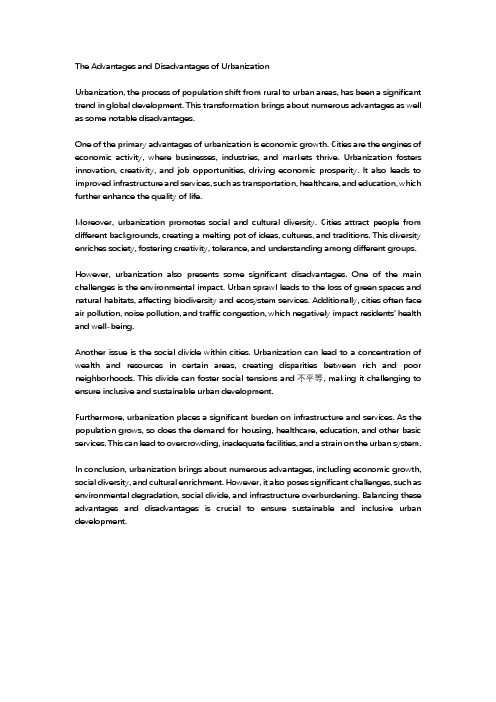
The Advantages and Disadvantages of UrbanizationUrbanization, the process of population shift from rural to urban areas, has been a significant trend in global development. This transformation brings about numerous advantages as well as some notable disadvantages.One of the primary advantages of urbanization is economic growth. Cities are the engines of economic activity, where businesses, industries, and markets thrive. Urbanization fosters innovation, creativity, and job opportunities, driving economic prosperity. It also leads to improved infrastructure and services, such as transportation, healthcare, and education, which further enhance the quality of life.Moreover, urbanization promotes social and cultural diversity. Cities attract people from different backgrounds, creating a melting pot of ideas, cultures, and traditions. This diversity enriches society, fostering creativity, tolerance, and understanding among different groups.However, urbanization also presents some significant disadvantages. One of the main challenges is the environmental impact. Urban sprawl leads to the loss of green spaces and natural habitats, affecting biodiversity and ecosystem services. Additionally, cities often face air pollution, noise pollution, and traffic congestion, which negatively impact residents' health and well-being.Another issue is the social divide within cities. Urbanization can lead to a concentration of wealth and resources in certain areas, creating disparities between rich and poor neighborhoods. This divide can foster social tensions and不平等, making it challenging to ensure inclusive and sustainable urban development.Furthermore, urbanization places a significant burden on infrastructure and services. As the population grows, so does the demand for housing, healthcare, education, and other basic services. This can lead to overcrowding, inadequate facilities, and a strain on the urban system.In conclusion, urbanization brings about numerous advantages, including economic growth, social diversity, and cultural enrichment. However, it also poses significant challenges, such as environmental degradation, social divide, and infrastructure overburdening. Balancing these advantages and disadvantages is crucial to ensure sustainable and inclusive urban development.。
(完整版)英语作文 城市化的利弊(Advantages and Disadvantages of Unbanization)-精品 (3)
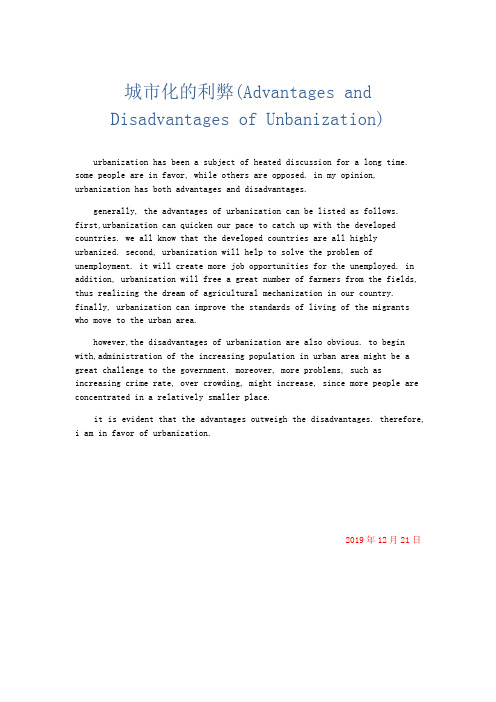
城市化的利弊(Advantages andDisadvantages of Unbanization)urbanization has been a subject of heated discussion for a long time. some people are in favor, while others are opposed. in my opinion, urbanization has both advantages and disadvantages.generally, the advantages of urbanization can be listed as follows. first,urbanization can quicken our pace to catch up with the developed countries. we all know that the developed countries are all highly urbanized. second, urbanization will help to solve the problem of unemployment. it will create more job opportunities for the unemployed. in addition, urbanization will free a great number of farmers from the fields, thus realizing the dream of agricultural mechanization in our country. finally, urbanization can improve the standards of living of the migrants who move to the urban area.however,the disadvantages of urbanization are also obvious. to begin with,administration of the increasing population in urban area might be a great challenge to the government. moreover, more problems, such as increasing crime rate, over crowding, might increase, since more people are concentrated in a relatively smaller place.it is evident that the advantages outweigh the disadvantages. therefore, i am in favor of urbanization.2019年12月21日。
城市化的优势和劣势英语作文总结
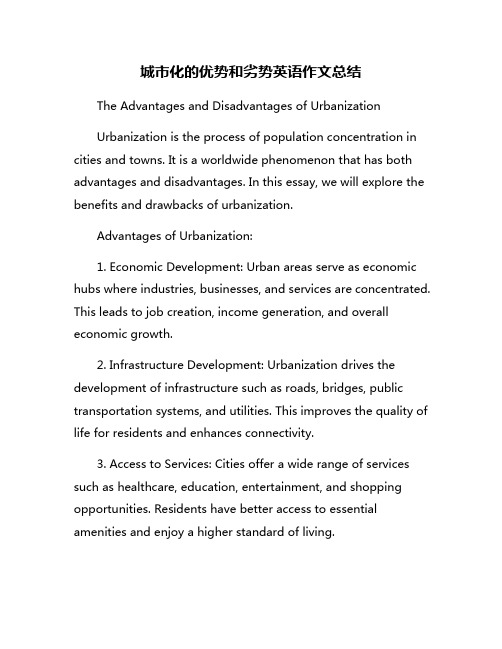
城市化的优势和劣势英语作文总结The Advantages and Disadvantages of UrbanizationUrbanization is the process of population concentration in cities and towns. It is a worldwide phenomenon that has both advantages and disadvantages. In this essay, we will explore the benefits and drawbacks of urbanization.Advantages of Urbanization:1. Economic Development: Urban areas serve as economic hubs where industries, businesses, and services are concentrated. This leads to job creation, income generation, and overall economic growth.2. Infrastructure Development: Urbanization drives the development of infrastructure such as roads, bridges, public transportation systems, and utilities. This improves the quality of life for residents and enhances connectivity.3. Access to Services: Cities offer a wide range of services such as healthcare, education, entertainment, and shopping opportunities. Residents have better access to essential amenities and enjoy a higher standard of living.4. Cultural Diversity: Urban areas are melting pots of different cultures, languages, and traditions. This diversity enriches the social fabric of cities and promotes cross-cultural understanding.5. Innovation and Creativity: Urban environments foster creativity and innovation due to the interactions between individuals from various backgrounds. This leads to the development of new ideas, technologies, and solutions to societal challenges.Disadvantages of Urbanization:1. Overpopulation: Rapid urbanization can lead to overpopulation in cities, resulting in overcrowding, strain on resources, and social problems such as poverty, crime, and pollution.2. Environmental Degradation: Urban areas often face environmental challenges such as air and water pollution, deforestation, and loss of biodiversity. The increased demand for land and resources also contributes to habitat destruction.3. Traffic Congestion: Urbanization is associated with increased vehicular traffic, leading to congestion, accidents, and air pollution. This affects mobility and quality of life for residents.4. Social Inequality: Urbanization can exacerbate social inequality as wealth and opportunities are concentrated in urban centers. This leads to disparities in access to education, healthcare, housing, and employment.5. Urban Sprawl: Unplanned urbanization can result in urban sprawl, where cities spread outwards without proper infrastructure and services. This leads to inefficient land use, lack of connectivity, and increased commuting times.In conclusion, urbanization has both advantages and disadvantages. While it promotes economic development, infrastructure, and cultural diversity, it also poses challenges such as overpopulation, environmental degradation, and social inequality. To mitigate the negative impacts of urbanization, policymakers and urban planners must focus on sustainable development, smart growth strategies, and inclusive policies that benefit all residents.。
城市化的利弊英语作文
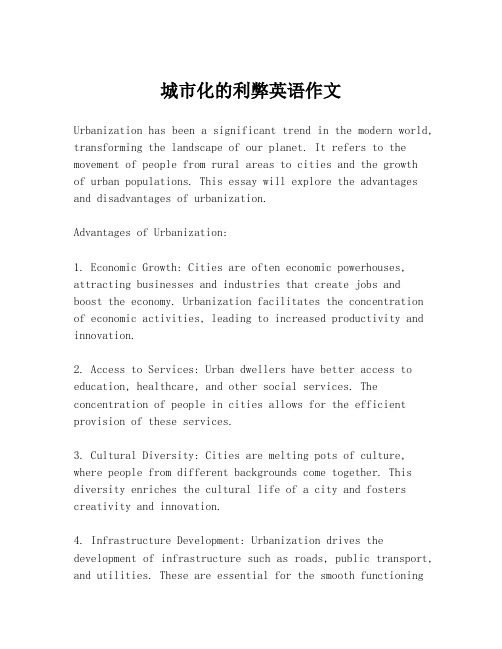
城市化的利弊英语作文Urbanization has been a significant trend in the modern world, transforming the landscape of our planet. It refers to the movement of people from rural areas to cities and the growthof urban populations. This essay will explore the advantages and disadvantages of urbanization.Advantages of Urbanization:1. Economic Growth: Cities are often economic powerhouses, attracting businesses and industries that create jobs andboost the economy. Urbanization facilitates the concentration of economic activities, leading to increased productivity and innovation.2. Access to Services: Urban dwellers have better access to education, healthcare, and other social services. The concentration of people in cities allows for the efficient provision of these services.3. Cultural Diversity: Cities are melting pots of culture, where people from different backgrounds come together. This diversity enriches the cultural life of a city and fosters creativity and innovation.4. Infrastructure Development: Urbanization drives the development of infrastructure such as roads, public transport, and utilities. These are essential for the smooth functioningof a city and improve the quality of life for its residents.Disadvantages of Urbanization:1. Overcrowding: One of the most significant issues with urbanization is overcrowding. As more people move to cities, there is increased pressure on housing, leading to high rents and property prices.2. Environmental Impact: The growth of cities can lead to environmental degradation. Increased pollution, traffic congestion, and the loss of green spaces are common problems associated with urbanization.3. Social Inequality: While cities offer opportunities, they also harbor social inequalities. The gap between the rich and the poor can widen, leading to issues such as poverty and homelessness.4. Strain on Resources: The rapid growth of urban populations puts a strain on resources such as water, electricity, and food. This can lead to shortages and increased costs for essential commodities.In conclusion, urbanization is a complex phenomenon with both positive and negative implications. While it can drive economic growth and improve access to services, it also brings challenges such as overcrowding and environmental degradation. It is crucial for policymakers to address these issues to ensure sustainable urban development that benefits all residents.。
城市化可能带来的优点与缺点英语作文
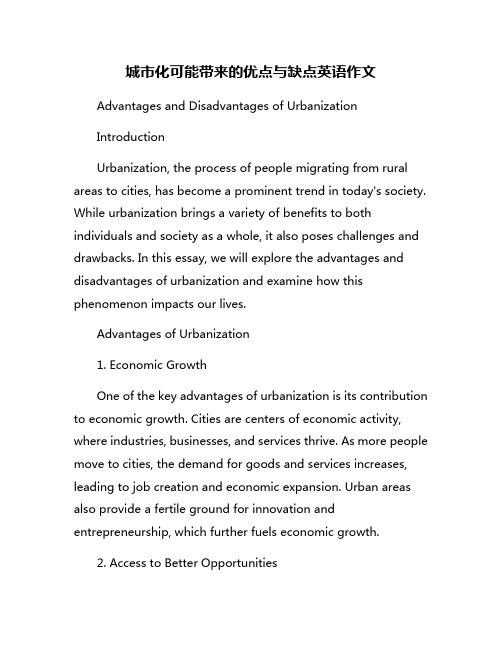
城市化可能带来的优点与缺点英语作文Advantages and Disadvantages of UrbanizationIntroductionUrbanization, the process of people migrating from rural areas to cities, has become a prominent trend in today's society. While urbanization brings a variety of benefits to both individuals and society as a whole, it also poses challenges and drawbacks. In this essay, we will explore the advantages and disadvantages of urbanization and examine how this phenomenon impacts our lives.Advantages of Urbanization1. Economic GrowthOne of the key advantages of urbanization is its contribution to economic growth. Cities are centers of economic activity, where industries, businesses, and services thrive. As more people move to cities, the demand for goods and services increases, leading to job creation and economic expansion. Urban areas also provide a fertile ground for innovation and entrepreneurship, which further fuels economic growth.2. Access to Better OpportunitiesUrbanization offers individuals access to better job opportunities, education, healthcare, and social services. Cities are hubs of diverse industries and institutions, providing a wide range of career options for individuals seeking employment. Moreover, urban areas often have better schools, hospitals, and recreational facilities, offering residents a higher quality of life.3. Infrastructure DevelopmentCities are characterized by well-developed infrastructure, including roads, public transportation, utilities, and communication networks. Urbanization drives investment in infrastructure development, leading to improved connectivity, efficiency, and convenience for residents. Access to modern amenities enhances the overall living standards of urban dwellers and improves their quality of life.4. Cultural DiversityUrbanization fosters cultural diversity by bringing together people from different backgrounds, beliefs, and traditions. Cities are melting pots of diverse cultures, languages, and cuisines, creating a vibrant and dynamic social environment. Exposure to different cultures broadens people's perspectives, promotes tolerance and understanding, and enriches the cultural fabric of society.Disadvantages of Urbanization1. Overcrowding and PollutionUrbanization often results in overcrowding, as cities struggle to accommodate the influx of people. Overcrowded cities face challenges such as housing shortages, traffic congestion, and insufficient public services. Additionally, urbanization contributes to environmental pollution, including air pollution, water contamination, and waste accumulation, degrading the quality of life and endangering public health.2. Income InequalityUrbanization exacerbates income inequality, as cities become divided between affluent and marginalized populations. Wealthier residents tend to cluster in exclusive neighborhoods with access to premium amenities, while low-income individuals are confined to overcrowded slums with inadequate living conditions. Income inequality in urban areas leads to social tensions, crime rates, and disparities in health and education.3. Strain on ResourcesUrbanization places a strain on resources such as water, energy, and land, as cities consume vast quantities of resources to sustain their population and infrastructure. Rapid urbanizationdepletes natural resources, exacerbates environmental degradation, and accelerates climate change. Additionally, the demand for resources in cities often exceeds supply, leading to shortages, price hikes, and competition among residents.4. Social IsolationUrbanization can contribute to social isolation and alienation among city residents, as the fast-paced urban lifestyle leaves little time for social interactions and community engagement. The anonymity of urban living can lead to feelings of loneliness, disconnectedness, and lack of social support. Moreover, the transient nature of urban populations, with people constantly moving in and out of cities, hinders the development of strong social ties and cohesive communities.ConclusionIn conclusion, urbanization presents a complex mix of advantages and disadvantages that shape our urban landscapes and influence our daily lives. While urbanization drives economic growth, provides better opportunities, and fosters cultural diversity, it also leads to overcrowding, pollution, income inequality, resource strain, and social isolation. As we navigate the challenges of urbanization, it is crucial to strike a balance between the benefits and drawbacks of urban living, ensuringsustainable, inclusive, and livable cities for all residents. By addressing the negative impacts of urbanization and harnessing its potential for positive change, we can create vibrant, resilient, and equitable urban environments that enhance the well-being and prosperity of society as a whole.。
中国城镇化的利与弊英语作文

中国城镇化的利与弊英语作文The Advantages and Disadvantages of Urbanization inChinaUrbanization, the process of population shifting from rural to urban areas, has been a significant trend in China over the past few decades. This phenomenon has both advantages and disadvantages. In this essay, we willexplore the benefits and drawbacks of urbanization in China.Advantages:1. Economic development: Urbanization can stimulate economic growth by creating job opportunities, promoting industrialization, and attracting investment. Cities are hubs of economic activities, and the concentration ofpeople in urban areas can lead to increased productivityand innovation.2. Infrastructure improvement: Urbanization often leadsto the development of better infrastructure such as roads, public transportation, and utilities. This can enhance the quality of life for urban residents and improve access to essential services.3. Social progress: Urban areas tend to offer more educational, healthcare, and cultural opportunities compared to rural areas. As more people move to cities,there is a greater chance for social mobility and advancement.4. Environmental benefits: Urbanization can help protect natural resources by promoting sustainable practices and reducing per capita energy consumption. With proper urban planning, cities can become more environmentally friendly and reduce their carbon footprint.Disadvantages:1. Overcrowding: Rapid urbanization can lead to overcrowding and strain on resources such as housing, water, and sanitation. This can result in poor living conditions, increased pollution, and social unrest.2. Income inequality: Urbanization can widen the gap between the rich and the poor, as cities tend to attract wealthier individuals and businesses. This can lead tosocial disparities, resentment, and lack of social cohesion.3. Loss of cultural heritage: As traditional rural communities are abandoned in favor of urban life, there is a risk of losing cultural heritage and local customs. This can result in a loss of identity and sense of belonging for some individuals.4. Urban sprawl: Unplanned urbanization can lead to urban sprawl, where cities expand uncontrollably into surrounding areas. This can result in loss of farmland, natural habitats, and increased traffic congestion.总结:城镇化在中国带来了许多好处,如经济发展、基础设施改善、社会进步和环境效益。
城市化的利弊大学英语作文

城市化的利弊大学英语作文The Advantages and Disadvantages of UrbanizationUrbanization, as an irreversible trend in modern society, has brought about significant changes to our world. It is a process that involves the mass migration of people from rural to urban areas, leading to the expansion and development of cities. This essay aims to discuss both the advantages and disadvantages of urbanization.AdvantagesFirstly, urbanization promotes economic growth. Cities are the centers of economic activity, where industries, businesses, and job opportunities flourish. The concentration of human resources and capital in urban areas creates a vibrant economy, leading to higher productivity and income levels. Moreover, urbanization encourages innovation and the exchange of ideas, fostering technological advancements and cultural diversity.Secondly, urbanization improves access to basic services and infrastructure. Cities usually offer better healthcare, education, transportation, and sanitation facilities compared to rural areas. This results in an improved quality of life for residents, with easier access to jobs, healthcare, and educational opportunities.Thirdly, urbanization contributes to environmental sustainability. Dense urban populations can be more efficient in terms of resourceusage and energy consumption. The proximity of homes, workplaces, and amenities in cities reduces the need for transportation, leading to lower carbon emissions. Additionally, urban areas often implement stricter environmental regulations and recycling programs.DisadvantagesDespite these advantages, urbanization also brings several challenges. One major drawback is the increase in inequality and social stratification. The rapid growth of cities often leads to the formation of slums and informal settlements, where living conditions are poor. The gap between the rich and the poor widens, resulting in social unrest and crime.Another disadvantage is the environmental impact of urbanization. The expansion of cities leads to deforestation, loss of biodiversity, and increased pollution levels. Urban areas face issues such as air and water pollution, noise pollution, and waste management problems. The concentration of people and vehicles in cities also contributes to traffic congestion and commuting challenges.Lastly, urbanization can lead to a loss of community and social cohesion. The anonymity and fast-paced lifestyle of cities often result in a breakdown of traditional social structures and a decrease in community engagement. This can lead to increased feelings of isolation, stress, and mental health issues among urban residents.In conclusion, urbanization has both advantages and disadvantages.While it promotes economic growth, improves access to services, and fosters innovation, it also brings challenges such as inequality, environmental issues, and social disconnection. It is crucial for policymakers and urban planners to address these challenges and find ways to create sustainable, inclusive cities for all residents.。
中国城市化的好处和坏处英语作文
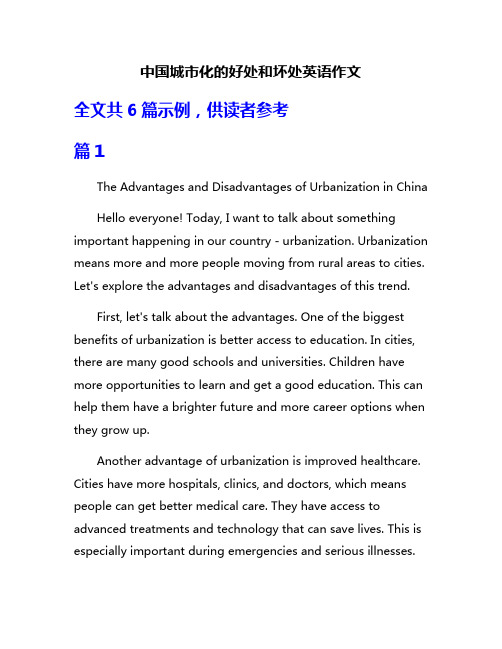
中国城市化的好处和坏处英语作文全文共6篇示例,供读者参考篇1The Advantages and Disadvantages of Urbanization in ChinaHello everyone! Today, I want to talk about something important happening in our country - urbanization. Urbanization means more and more people moving from rural areas to cities. Let's explore the advantages and disadvantages of this trend.First, let's talk about the advantages. One of the biggest benefits of urbanization is better access to education. In cities, there are many good schools and universities. Children have more opportunities to learn and get a good education. This can help them have a brighter future and more career options when they grow up.Another advantage of urbanization is improved healthcare. Cities have more hospitals, clinics, and doctors, which means people can get better medical care. They have access to advanced treatments and technology that can save lives. This is especially important during emergencies and serious illnesses.Moreover, urbanization brings more job opportunities. In cities, there are many companies and businesses that need workers. People can find different kinds of jobs and earn a better income. This can improve their living standards and help them provide a good life for their families.Despite these advantages, there are also some disadvantages of urbanization. One major concern is the high cost of living in cities. Housing, food, and transportation can be more expensive compared to rural areas. This can make it difficult for some families to afford basic necessities and lead to financial stress.Additionally, urbanization can lead to environmental problems. As cities grow, more buildings are constructed, and more vehicles are on the roads. This can cause air and water pollution, as well as congestion and traffic jams. It is important for cities to implement eco-friendly solutions and sustainable development to protect the environment.Furthermore, urbanization can lead to the loss of traditional culture and values. In rural areas, people have strong connections to their land, history, and traditions. But when they move to cities, they may lose touch with their cultural roots. It isnecessary to preserve and promote our traditional culture, even in urban areas.In conclusion, urbanization in China has both advantages and disadvantages. It provides better education, healthcare, and job opportunities, but it also comes with a higher cost of living, environmental challenges, and cultural changes. It is important for the government and citizens to work together to make cities more livable, sustainable, and inclusive for everyone.Remember, no matter where we live - in cities or in rural areas - we should always cherish our communities, take care of the environment, and keep learning and growing.篇2The Advantages and Disadvantages of Urbanization in ChinaHello friends! Today, I want to talk about something very important that is happening in our country - urbanization. Urbanization means the growth of cities and the movement of people from rural areas to urban areas. China has experienced rapid urbanization in recent years, and it has both advantages and disadvantages. Let's explore them together!First, let's talk about the advantages of urbanization. One of the biggest benefits is that cities provide more job opportunities. When people move from rural areas to cities, they can find better-paying jobs and improve their living standards. This means they can earn more money to support their families and have a better quality of life.Another advantage of urbanization is better access to education and healthcare. Cities have more schools and hospitals, which means children can get a good education and people can receive better medical care. This can lead to a healthier and more educated population, which is important for the development of our country.Urbanization also brings improved infrastructure. Cities have modern transportation systems like subways, buses, and highways, making it easier for people to travel around. Moreover, cities have better facilities like shopping malls, parks, and entertainment venues, providing people with more recreational options.However, we must also consider the disadvantages of urbanization. One major problem is overpopulation. As more people move to cities, the population becomes concentrated in urban areas, leading to overcrowding. This can put a strain onresources such as housing, water, and electricity. It is important for the government to plan and manage urbanization properly to avoid these issues.Another disadvantage is pollution. Cities produce a lot of pollution from factories, vehicles, and waste. This can harm the environment and affect people's health. It is crucial for us to find ways to reduce pollution and protect our environment. We can encourage the use of clean energy, promote recycling, and plant more trees in cities to improve air quality.In addition, urbanization can lead to the loss of traditional culture and the disappearance of farmland. As cities expand, they may encroach on rural areas, resulting in the loss of agricultural land. It is important to preserve our cultural heritage and find a balance between development and conservation.In conclusion, urbanization in China has both advantages and disadvantages. It brings job opportunities, better education and healthcare, and improved infrastructure. However, it also causes overpopulation, pollution, and the loss of traditional culture. As young citizens, we should be aware of these issues and work together to create a sustainable and harmonious urban environment for future generations.Remember, it is important to build cities that are not only modern and developed but also environmentally friendly and culturally rich. Let's strive for a better future for our country!I hope you found this essay helpful and informative. Good luck with your studies!篇3当然可以!以下是一篇关于中国城市化的好处和坏处的英语作文,使用小学生的语言风格。
城镇化的好处和坏处四级英语作文
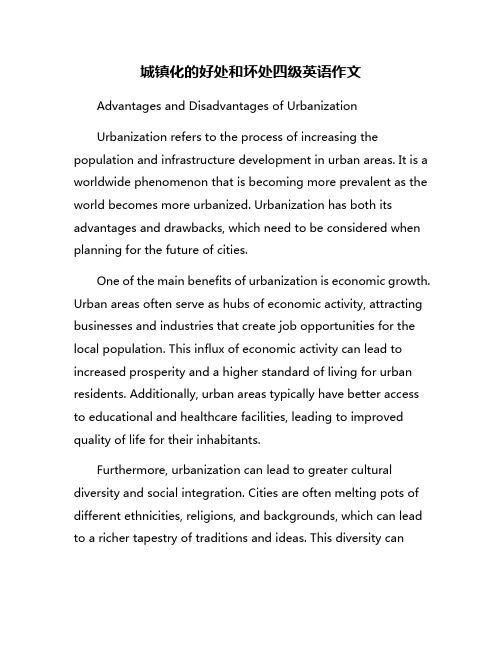
城镇化的好处和坏处四级英语作文Advantages and Disadvantages of UrbanizationUrbanization refers to the process of increasing the population and infrastructure development in urban areas. It is a worldwide phenomenon that is becoming more prevalent as the world becomes more urbanized. Urbanization has both its advantages and drawbacks, which need to be considered when planning for the future of cities.One of the main benefits of urbanization is economic growth. Urban areas often serve as hubs of economic activity, attracting businesses and industries that create job opportunities for the local population. This influx of economic activity can lead to increased prosperity and a higher standard of living for urban residents. Additionally, urban areas typically have better access to educational and healthcare facilities, leading to improved quality of life for their inhabitants.Furthermore, urbanization can lead to greater cultural diversity and social integration. Cities are often melting pots of different ethnicities, religions, and backgrounds, which can lead to a richer tapestry of traditions and ideas. This diversity canfoster a sense of inclusivity and tolerance among urban dwellers, promoting social cohesion and understanding.However, urbanization also comes with its downsides. One of the most significant drawbacks is environmental degradation. As cities grow and expand, they often encroach on natural habitats and ecosystems, leading to deforestation, pollution, and the depletion of natural resources. This can have far-reaching consequences on the environment, including climate change, loss of biodiversity, and increased air and water pollution.Another downside of urbanization is the strain it puts on infrastructure and public services. As more people move into urban areas, the demand for housing, transportation, and utilities increases, putting pressure on existing infrastructure. This can lead to overcrowding, traffic congestion, and inadequate access to basic services such as water, sanitation, and healthcare.In conclusion, urbanization has both its advantages and disadvantages. While it can spur economic growth, cultural diversity, and social integration, it also has negative impacts on the environment and can strain infrastructure and public services. As cities continue to grow and urbanize, it is essential to consider these factors and plan for sustainable and inclusive urbandevelopment that balances the needs of residents with the preservation of the environment.。
城市化的优缺点和自己的观点英语作文
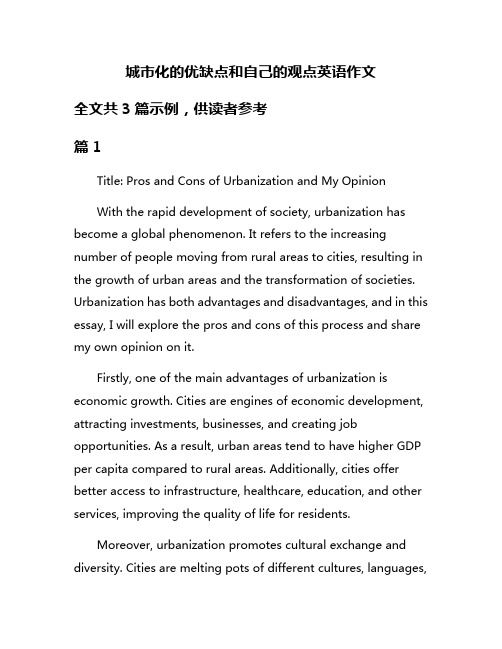
城市化的优缺点和自己的观点英语作文全文共3篇示例,供读者参考篇1Title: Pros and Cons of Urbanization and My OpinionWith the rapid development of society, urbanization has become a global phenomenon. It refers to the increasing number of people moving from rural areas to cities, resulting in the growth of urban areas and the transformation of societies. Urbanization has both advantages and disadvantages, and in this essay, I will explore the pros and cons of this process and share my own opinion on it.Firstly, one of the main advantages of urbanization is economic growth. Cities are engines of economic development, attracting investments, businesses, and creating job opportunities. As a result, urban areas tend to have higher GDP per capita compared to rural areas. Additionally, cities offer better access to infrastructure, healthcare, education, and other services, improving the quality of life for residents.Moreover, urbanization promotes cultural exchange and diversity. Cities are melting pots of different cultures, languages,and traditions, creating a dynamic and vibrant environment. People from diverse backgrounds come together, interact, and learn from each other, fostering tolerance and understanding.On the other hand, urbanization also brings about several disadvantages. One of the major drawbacks is environmental degradation. The rapid expansion of cities leads to deforestation, pollution, and the depletion of natural resources. Urban areas often suffer from air and water pollution, traffic congestion, and waste management issues, impacting the health and well-being of residents.Furthermore, urbanization can lead to social problems such as income inequality, crime rates, and overcrowding. As cities grow, the gap between the rich and the poor widens, creating social tensions and disparities. Moreover, the concentration of a large population in urban areas can strain public services and infrastructure, leading to overcrowding and inadequate housing conditions.In conclusion, urbanization has its pros and cons. While it contributes to economic growth, cultural exchange, and improved quality of life, it also poses challenges in terms of environmental sustainability, social equity, and public health. In my opinion, I believe that urbanization can be a beneficialprocess if managed effectively. Governments and urban planners should prioritize sustainable development, promote green technologies, invest in public transportation, and address social inequalities to ensure that urbanization benefits all members of society.By striking a balance between economic growth and environmental conservation, urbanization can create livable, inclusive, and resilient cities for present and future generations.篇2Title: Advantages and Disadvantages of Urbanization and My OpinionUrbanization is the process of population shifting from rural areas to urban areas, leading to the growth of cities and towns. This phenomenon has both positive and negative impacts on society and the environment. In this essay, we will discuss the advantages and disadvantages of urbanization and present my opinion on this controversial topic.Advantages of Urbanization:1. Economic Growth: Urbanization promotes economic development by creating job opportunities, attracting investments, and stimulating consumer demand. Cities serve ashubs for various industries, businesses, and services, contributing to the overall economic growth of a country.2. Infrastructure Development: Urban areas are equipped with better infrastructure facilities such as roads, railways, airports, and communication networks, which enhance transportation, communication, and connectivity. This leads to improved accessibility, efficiency, and convenience for residents and businesses.3. Social Opportunities: Cities offer a wide range of social, cultural, educational, and recreational opportunities. Urban residents have access to quality healthcare, education, entertainment, and social activities, leading to a higher standard of living and overall well-being.4. Innovation and Creativity: Urbanization fosters innovation, creativity, and knowledge exchange by bringing together diverse populations, ideas, and resources. Cities serve as centers of innovation, research, technology, and entrepreneurship, driving progress and development in various fields.Disadvantages of Urbanization:1. Overpopulation: Rapid urbanization can lead to overpopulation, overcrowding, and congestion in cities, resultingin increased pressure on resources, infrastructure, and public services. This can lead to social problems, inequality, and quality of life issues for residents.2. Environmental Degradation: Urbanization contributes to environmental degradation through pollution, deforestation, habitat loss, and resource depletion. Cities generate large amounts of waste, emissions, and pollution, leading to air, water, and soil contamination, and biodiversity loss.3. Urban Sprawl: Unplanned urbanization can lead to urban sprawl, the expansion of cities into surrounding rural areas, resulting in land degradation, habitat fragmentation, and loss of agricultural land. This can disrupt natural ecosystems, wildlife habitats, and biodiversity.4. Social Inequality: Urbanization can exacerbate social inequality, poverty, and social exclusion, as cities may concentrate wealth, resources, and opportunities in certain areas while neglecting others. This can lead to social tensions, crime, and marginalization of disadvantaged groups.My Opinion:In my opinion, urbanization is a double-edged sword with both advantages and disadvantages. While urbanization offerseconomic, social, and cultural benefits, it also poses challenges such as overpopulation, environmental degradation, and social inequality. To harness the benefits of urbanization while mitigating its negative impacts, sustainable urban planning, infrastructure development, and policy interventions are crucial. It is essential to promote compact, inclusive, and environmentally friendly cities that prioritize the well-being of residents, protect natural resources, and preserve biodiversity. By adopting sustainable urban practices and fostering equitable development, we can create livable, resilient, and prosperous cities for present and future generations.In conclusion, urbanization has the potential to drive economic growth, social progress, and innovation, but it also poses risks and challenges that must be addressed. By striking a balance between urban development and environmental conservation, we can create sustainable, inclusive, and thriving cities that benefit all residents and the planet. Urbanization should be guided by principles of sustainability, equity, and resilience to ensure a better future for urban populations and the environment.篇3With the rapid development of urbanization, more and more people are moving from rural areas to cities in search of better opportunities. Urbanization has both advantages and disadvantages, and in this essay, I will discuss the pros and cons of urbanization as well as my personal viewpoint on this issue.Firstly, let's talk about the advantages of urbanization. One of the main benefits of urbanization is economic growth. Cities serve as hubs for commerce, industry, and innovation, creating job opportunities and increasing the standard of living for residents. Urban areas also offer better access to services such as healthcare, education, transportation, and entertainment. Additionally, cities promote cultural exchange and diversity, fostering creativity and tolerance among the population.On the other hand, urbanization also has its drawbacks. One of the major disadvantages is overcrowding and congestion in cities, leading to pollution, traffic jams, and a high cost of living. Rapid urbanization can also put a strain on infrastructure and public services, resulting in inadequate housing, sanitation, and healthcare facilities. Furthermore, urbanization can lead to social problems such as crime, inequality, and social isolation, as people become disconnected from their communities andstruggle to find a sense of belonging in a fast-paced environment.In my opinion, urbanization is a double-edged sword that brings both benefits and challenges. While urban areas offer greater opportunities for economic advancement and personal growth, they also pose risks to the environment, public health, and social cohesion. It is essential for policymakers to address these issues and implement sustainable urban planning strategies that prioritize the well-being of residents and the environment.In conclusion, urbanization has its advantages and disadvantages, and it is crucial for society to strike a balance between economic development and social welfare. By promoting sustainable urbanization practices and investing in infrastructure, education, and social services, we can create thriving cities that offer a high quality of life for all residents. Urbanization is a complex and multifaceted phenomenon that requires careful consideration and planning to ensure a prosperous and harmonious future for generations to come.。
英语作文城市化的优势和劣势
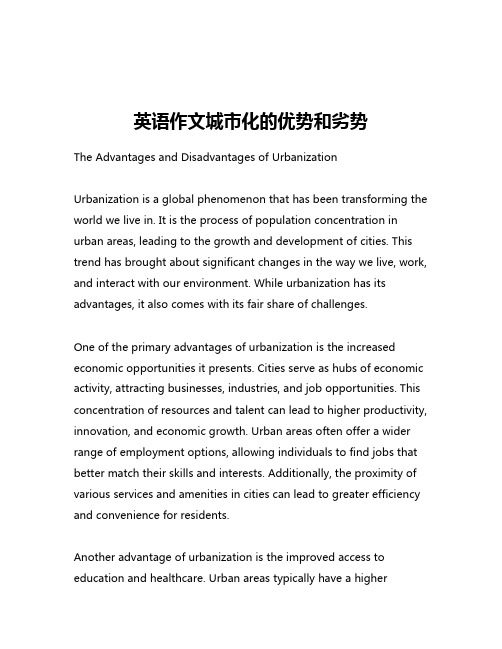
英语作文城市化的优势和劣势The Advantages and Disadvantages of UrbanizationUrbanization is a global phenomenon that has been transforming the world we live in. It is the process of population concentration in urban areas, leading to the growth and development of cities. This trend has brought about significant changes in the way we live, work, and interact with our environment. While urbanization has its advantages, it also comes with its fair share of challenges.One of the primary advantages of urbanization is the increased economic opportunities it presents. Cities serve as hubs of economic activity, attracting businesses, industries, and job opportunities. This concentration of resources and talent can lead to higher productivity, innovation, and economic growth. Urban areas often offer a wider range of employment options, allowing individuals to find jobs that better match their skills and interests. Additionally, the proximity of various services and amenities in cities can lead to greater efficiency and convenience for residents.Another advantage of urbanization is the improved access to education and healthcare. Urban areas typically have a higherconcentration of educational institutions, from primary schools to universities, providing more opportunities for individuals to acquire knowledge and skills. The proximity of healthcare facilities, such as hospitals and clinics, in cities can also lead to better healthcare outcomes, as residents have easier access to medical services and specialized treatments.Furthermore, urbanization can foster cultural diversity and creativity. Cities often serve as melting pots, attracting people from different backgrounds, ethnicities, and cultures. This diversity can lead to the exchange of ideas, the development of new art forms, and the emergence of vibrant cultural scenes. Urban areas can also provide platforms for artistic expression, such as theaters, museums, and performance venues, enriching the lives of residents and visitors alike.However, urbanization also comes with significant challenges that must be addressed. One of the most pressing issues is the strain on infrastructure and resources. The rapid influx of people into urban areas can overwhelm the existing infrastructure, leading to problems such as overcrowding, traffic congestion, and overburdened public services. This can result in decreased quality of life for residents, as they face longer commute times, limited access to essential services, and a decline in the overall living standards.Another challenge of urbanization is the impact on the environment.The concentration of people and economic activities in cities can lead to increased pollution, resource depletion, and environmental degradation. Urban areas often generate high levels of greenhouse gas emissions, contributing to climate change. Additionally, the expansion of cities can lead to the loss of natural habitats and the displacement of local communities, disrupting the delicate balance of ecosystems.Urbanization can also exacerbate social inequalities. The influx of people into cities can create a divide between the wealthy and the poor, as the cost of living often rises faster than the incomes of lower-income residents. This can lead to the formation of slums and the marginalization of certain communities, further perpetuating social and economic disparities.Moreover, the rapid growth of cities can pose challenges to urban planning and governance. Policymakers and city officials must navigate complex issues such as housing, transportation, waste management, and public safety, often with limited resources and competing priorities. Effective urban planning and governance are crucial to ensuring that the benefits of urbanization are equitably distributed and the negative impacts are mitigated.In conclusion, urbanization is a complex phenomenon that presents both advantages and disadvantages. While it offers economicopportunities, improved access to education and healthcare, and cultural diversity, it also poses significant challenges related to infrastructure, the environment, social inequalities, and urban planning. As the world continues to urbanize, it is crucial for policymakers, urban planners, and citizens to work collaboratively to address these challenges and harness the potential of urbanization to create more sustainable and inclusive cities.。
高考英语作文:城市生活的利与弊(Advantage and Disadvantages of Living in the city)

城市生活的利与弊(Advantage and Disadvantages of Living in the city) 根据下面提示,写一篇词数为100左右的关于城市生活的利和弊的文章。
advantages disadvantages找工作容易生活消费高交通便利人口多,拥挤有公园、饭店等休闲场所空气污染、居住环境差要求:1.覆盖以上内容,可作适当发挥。
2.词数100左右。
城市生活的利与弊(advantage and disadvantages of living in the city)living in a city has both advantages and disadvantages. it is often easier to find work. there are always many choices of public transport. besides, there are a lot of interesting things to do and places to see. you can eat in good restaurants, visit museums, go to cinemas and go to parks whenever you want to relax. however, living in a city is often very expensive. you must find a well-paid job, otherwise, you will not be able to afford the things you will do. what’s m ore,the city is always crowded, noisy and dirty. it is very difficult to find a good place where people can enjoy peace and fresh air as in the countryside.。
城市化好处与坏处的简单的英语作文
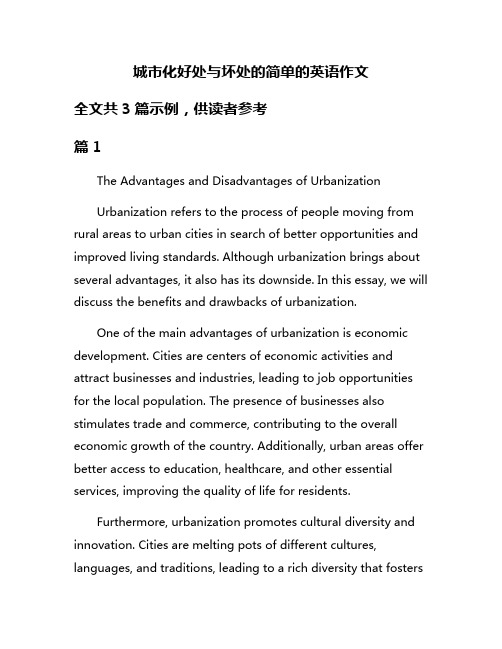
城市化好处与坏处的简单的英语作文全文共3篇示例,供读者参考篇1The Advantages and Disadvantages of UrbanizationUrbanization refers to the process of people moving from rural areas to urban cities in search of better opportunities and improved living standards. Although urbanization brings about several advantages, it also has its downside. In this essay, we will discuss the benefits and drawbacks of urbanization.One of the main advantages of urbanization is economic development. Cities are centers of economic activities and attract businesses and industries, leading to job opportunities for the local population. The presence of businesses also stimulates trade and commerce, contributing to the overall economic growth of the country. Additionally, urban areas offer better access to education, healthcare, and other essential services, improving the quality of life for residents.Furthermore, urbanization promotes cultural diversity and innovation. Cities are melting pots of different cultures, languages, and traditions, leading to a rich diversity that fosterscreativity and new ideas. This diversity also promotes tolerance and understanding among people from different backgrounds, creating a more inclusive society.On the other hand, urbanization also has its drawbacks. One of the main disadvantages is overpopulation and congestion. As more people move to cities, the population density increases, leading to overcrowding and lack of space. This can result in traffic congestion, air pollution, and increased stress on public infrastructure such as transportation, water supply, and waste management.Moreover, urbanization can also lead to social issues such as poverty, crime, and inequality. As more people migrate to cities in search of better opportunities, there is a risk of creating a divide between the rich and the poor. This can result in social unrest and instability, leading to an increase in crime rates and other social problems.In conclusion, urbanization has both advantages and disadvantages. While it promotes economic development, cultural diversity, and innovation, it also leads to overpopulation, congestion, and social issues. It is important for policymakers to address these challenges and ensure sustainable urbandevelopment that benefits all residents. Only then can urbanization be truly beneficial for society as a whole.篇2The Advantages and Disadvantages of UrbanizationUrbanization, refers to the process of increasing the population and societal complexity of cities. It is a double-edged sword that brings both benefits and drawbacks to society. In this essay, we will explore the advantages and disadvantages of urbanization.First and foremost, urbanization leads to economic growth. Cities are hubs for commerce, industry, and innovation. They attract businesses, investments, and skilled labor, which stimulate economic development. Urban areas contribute significantly to the national GDP and provide employment opportunities for millions of people.Furthermore, urbanization brings about improved infrastructure and services. Cities have better transportation systems, healthcare facilities, and educational institutions compared to rural areas. The availability of essential services enhances the quality of life for urban residents and promotes overall well-being.In addition, urbanization facilitates cultural exchange and diversity. Cities are melting pots of different cultures, religions, and traditions. People from diverse backgrounds coexist and interact, fostering mutual understanding and tolerance. This cultural exchange enriches society and promotes social cohesion.On the other hand, urbanization also has its downsides. One of the major drawbacks is urban sprawl and environmental degradation. As cities expand, they encroach upon natural habitats and farmland, leading to deforestation, pollution, and loss of biodiversity. These environmental issues pose serious challenges to sustainability and public health.Moreover, urbanization exacerbates social inequalities and poverty. While cities offer opportunities for economic advancement, they also concentrate wealth and resources in the hands of a few. This creates disparities in income, education, and healthcare access, widening the gap between the rich and poor. Marginalized groups often face discrimination and exclusion in urban areas.Furthermore, urbanization strains public resources and infrastructure. Cities struggle to cope with the rapid influx of migrants, resulting in overcrowded housing, inadequatesanitation, and insufficient public services. This overburdened infrastructure leads to congestion, traffic jams, and social unrest, affecting the overall livability of urban areas.In conclusion, urbanization is a complex phenomenon with both advantages and disadvantages. While it drives economic growth, improves infrastructure, and fosters cultural diversity, it also contributes to environmental degradation, social inequalities, and resource depletion. To harness the benefits of urbanization and mitigate its negative impacts, policymakers, urban planners, and communities need to adopt sustainable and inclusive development strategies. Only by addressing these challenges can we build cities that are vibrant, inclusive, and resilient for future generations.篇3Title: The Pros and Cons of UrbanizationUrbanization refers to the process of population migration from rural areas to urban areas. The increasing rate of urbanization has both positive and negative impacts on society and the environment. In this essay, we will discuss the benefits and drawbacks of urbanization.Firstly, urbanization brings about economic growth. Cities are hubs of economic activities where industries, businesses, and services are concentrated. This leads to job creation and income generation for the urban population. As more people migrate to cities in search of better opportunities, it fuels economic development and helps in reducing poverty levels.Secondly, urbanization enhances access to healthcare and education. Cities usually have better healthcare facilities and educational institutions compared to rural areas. This enables individuals to access quality healthcare services and educational opportunities, thereby improving their overall well-being and standard of living.Furthermore, urbanization promotes cultural diversity and social integration. Cities are melting pots of different cultures, traditions, and beliefs. This cultural exchange fosters tolerance, understanding, and social harmony among people from diverse backgrounds. In addition, urban areas offer a wide range of recreational and entertainment options, contributing to a vibrant and dynamic lifestyle.On the other hand, urbanization also has its downsides. One of the major drawbacks of urbanization is environmental degradation. The rapid expansion of cities results in thedestruction of natural habitats, deforestation, pollution, and resource depletion. This has a detrimental impact on the environment, leading to climate change, loss of biodiversity, and public health risks.Moreover, urbanization exacerbates social inequality and urban poverty. While cities offer opportunities for economic growth, not everyone benefits equally from these opportunities. The urban poor often face social exclusion, inadequate housing, lack of basic services, and limited access to education and healthcare. This widening gap between the rich and the poor creates social tensions and undermines social cohesion.In conclusion, urbanization has both advantages and disadvantages. It is essential to strike a balance between economic growth, environmental sustainability, and social equity to ensure inclusive and sustainable urban development. Government policies and urban planning strategies play a crucial role in managing the challenges of urbanization and harnessing its benefits for the well-being of all citizens.。
(完整版)英语作文 城市化的利弊(Advantages and Disadvantages of Unbanization)-精品 (3)

城市化的利弊(Advantages andDisadvantages of Unbanization)urbanization has been a subject of heated discussion for a long time. some people are in favor, while others are opposed. in my opinion, urbanization has both advantages and disadvantages.generally, the advantages of urbanization can be listed as follows. first,urbanization can quicken our pace to catch up with the developed countries. we all know that the developed countries are all highly urbanized. second, urbanization will help to solve the problem of unemployment. it will create more job opportunities for the unemployed. in addition, urbanization will free a great number of farmers from the fields, thus realizing the dream of agricultural mechanization in our country. finally, urbanization can improve the standards of living of the migrants who move to the urban area.however,the disadvantages of urbanization are also obvious. to begin with,administration of the increasing population in urban area might be a great challenge to the government. moreover, more problems, such as increasing crime rate, over crowding, might increase, since more people are concentrated in a relatively smaller place.it is evident that the advantages outweigh the disadvantages. therefore, i am in favor of urbanization.2019年12月21日。
城市化的利弊 英语作文
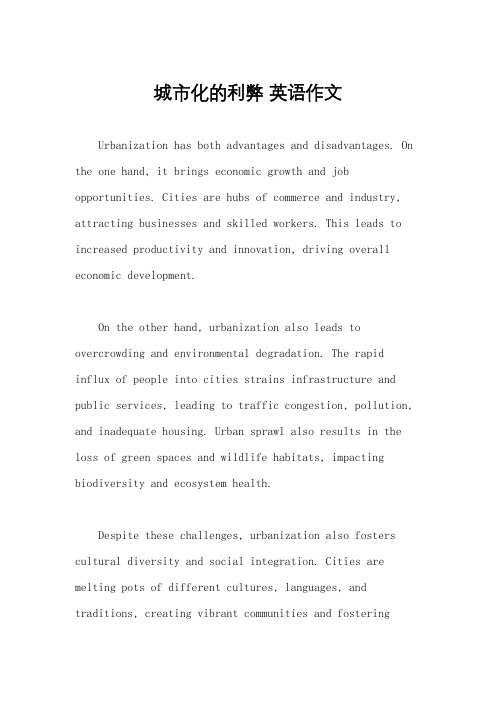
城市化的利弊英语作文Urbanization has both advantages and disadvantages. On the one hand, it brings economic growth and job opportunities. Cities are hubs of commerce and industry, attracting businesses and skilled workers. This leads to increased productivity and innovation, driving overall economic development.On the other hand, urbanization also leads to overcrowding and environmental degradation. The rapid influx of people into cities strains infrastructure and public services, leading to traffic congestion, pollution, and inadequate housing. Urban sprawl also results in the loss of green spaces and wildlife habitats, impacting biodiversity and ecosystem health.Despite these challenges, urbanization also fosters cultural diversity and social integration. Cities are melting pots of different cultures, languages, and traditions, creating vibrant communities and fosteringtolerance and understanding among people from diverse backgrounds. This cultural exchange enriches society and promotes social cohesion.However, urbanization also exacerbates socialinequality and poverty. As cities grow, disparities in income and access to services widen, creating pockets of deprivation and marginalization. The lack of affordable housing and basic amenities in urban areas perpetuates poverty and social exclusion, leading to social unrest and crime.In conclusion, urbanization is a double-edged sword, bringing both benefits and drawbacks. While it drives economic growth and cultural exchange, it also poses challenges such as environmental degradation and social inequality. It is essential for policymakers to address these issues and promote sustainable urban development that balances economic prosperity with social equity and environmental conservation.。
城市化的优势和劣势作文英语
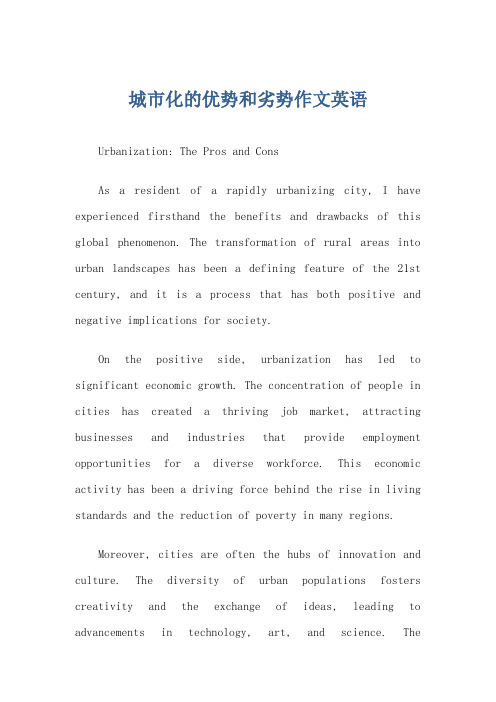
城市化的优势和劣势作文英语Urbanization: The Pros and ConsAs a resident of a rapidly urbanizing city, I have experienced firsthand the benefits and drawbacks of this global phenomenon. The transformation of rural areas into urban landscapes has been a defining feature of the 21st century, and it is a process that has both positive and negative implications for society.On the positive side, urbanization has led to significant economic growth. The concentration of people in cities has created a thriving job market, attracting businesses and industries that provide employment opportunities for a diverse workforce. This economic activity has been a driving force behind the rise in living standards and the reduction of poverty in many regions.Moreover, cities are often the hubs of innovation and culture. The diversity of urban populations fosters creativity and the exchange of ideas, leading to advancements in technology, art, and science. Theavailability of educational institutions and cultural events in cities enriches the lives of residents and contributes to the development of a knowledgeable and engaged citizenry.However, the disadvantages of urbanization are also apparent. One of the most pressing issues is the strain on infrastructure. As cities grow, the demand for housing, transportation, and public services increases, often outpacing the ability of cities to accommodate these needs. This can lead to overcrowding, traffic congestion, and a lack of access to essential services for many residents.Environmental concerns are another significant drawback of urbanization. The expansion of cities often comes at the expense of natural habitats, leading to deforestation and loss of biodiversity. Additionally, the increased use of resources and the production of waste in urban areas contribute to pollution and climate change.The social implications of urbanization are also complex. While cities can offer opportunities for social mobility, they can also perpetuate inequality. The high cost of living in cities can price out lower-incomeresidents, leading to the formation of economically segregated neighborhoods. This can exacerbate social divisions and limit access to resources and opportunities for those in need.Furthermore, the rapid pace of urbanization can lead to a loss of community and a sense of anonymity in cities. The anonymity of urban life can sometimes erode social connections and support networks, which are essential for individual well-being and community cohesion.In conclusion, urbanization is a multifaceted process with both advantages and disadvantages. While it can drive economic growth, innovation, and cultural richness, it also presents challenges related to infrastructure, the environment, social inequality, and community cohesion. As cities continue to grow, it is essential for policymakers and urban planners to address these issues to ensure that the benefits of urbanization are shared by all members of society.。
- 1、下载文档前请自行甄别文档内容的完整性,平台不提供额外的编辑、内容补充、找答案等附加服务。
- 2、"仅部分预览"的文档,不可在线预览部分如存在完整性等问题,可反馈申请退款(可完整预览的文档不适用该条件!)。
- 3、如文档侵犯您的权益,请联系客服反馈,我们会尽快为您处理(人工客服工作时间:9:00-18:30)。
城市化的利弊(Advantages and
Disadvantages of Unbanization)
urbanization has been a subject of heated discussion for a long time. some people are in favor, while others are opposed. in my opinion, urbanization has both advantages and disadvantages.
generally, the advantages of urbanization can be listed as follows. first,urbanization can quicken our pace to catch up with the developed countries. we all know that the developed countries are all highly urbanized. second, urbanization will help to solve the problem of unemployment. it will create more job opportunities for the unemployed. in addition, urbanization will free a great number of farmers from the fields, thus realizing the dream of agricultural mechanization in our country. finally, urbanization can improve the standards of living of the migrants who move to the urban area.
however,the disadvantages of urbanization are also obvious. to begin with,administration of the increasing population in urban area might be a great challenge to the government. moreover, more problems, such as increasing crime rate, over crowding, might increase, since more people are concentrated in a relatively smaller place.
it is evident that the advantages outweigh the disadvantages. therefore, i am in favor of urbanization.
2019年12月21日。
